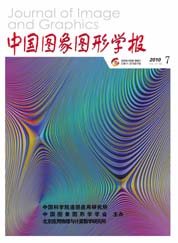
3维建模中视频图像与磁跟踪器的多模态标定在微创手术中的应用
摘 要
提出了一种全自动、多模态的信息融合解决方案用于配准视频图像和磁跟踪数据。该配准方案将用于内窥镜图像的三维数字成像系统以对人体的三维解剖结构的外观和尺度进行重建,特别是用于微创手术。多模态标定方法如下:首先医生将磁跟踪器插入并固定于内窥镜的工作通道;然后利用该器械组对一个棋盘格模板的各个视角进行若干秒的采集;内窥镜坐标和磁跟踪器坐标的相对关系(平移和旋转)就可以立刻得到。在手术过程中,磁跟踪器显示的读数将可以自动用来推算出内窥镜的坐标(位置和朝向),并有利于重建器官的三维结构。虽然目前已有一些深入研究的算法用于从图像中推算相机的运动,他们通常非常容易受到图像分析、误差积累、结构形变等的影响。从实验结果分析可知,该方案提出使用磁跟踪器推算相机运动参数的方法可行且提高了精度。此外,该方法不需要特殊的训练或者昂贵的设备。
关键词
Multiple-modality;Calibration;of;Video;and;Magnetic;Tracker;Data;for;3D;Appearance;and;Structure;Modeling;in;Minimally;Invasive;Surgery
QIN Wenjian, GU Jia(Key Laboratory for Biomedical Informatics and Health Engineering, Chinese Academy of Sciences, Shenzhen 518067) Abstract
The paper reports a fully-automated, multiple-modality sensor data registration scheme between video and magnetic tracker data. This registration scheme is intended for use in computerized imaging systems to model the appearance, structure, and dimension of human anatomy in three dimensions (3D) from endoscopic videos, particularly for minimally invasive surgery. The proposed multiple-modality calibration procedure operates this way: Before a surgical procedure, the surgeon inserts a magnetic tracker into the working channel of the endoscope or otherwise fixes the tracker’s position on the scope. The surgeon then maneuvers the scope-tracker assembly to view a checkerboard calibration pattern from a few different viewpoints for a few seconds. The calibration procedure is then completed, and the relative pose (translation and rotation) between the reference frames of the magnetic tracker and the scope is determined. During the surgical procedure, the readings from the magnetic tracker are used to automatically deduce the pose (both position and orientation) of the scope’s reference frame over time, without complicated image analysis. Knowing the scope movement over time then allows us to infer the 3D appearance and structure of the organs and tissues in the scene. While there are other well-established mechanisms for inferring the movement of the camera (scope) from images, they are often sensitive to mistakes in image analysis, error accumulation, and structure deformation. The proposed method using a magnetic tracker to establish the camera motion parameters thus is acceptable and high-precision from analysis of results. Furthermore, the calibration procedure does not require special training nor use expensive calibration equipment
Keywords
|



 中国图象图形学报 │ 京ICP备05080539号-4 │ 本系统由
中国图象图形学报 │ 京ICP备05080539号-4 │ 本系统由